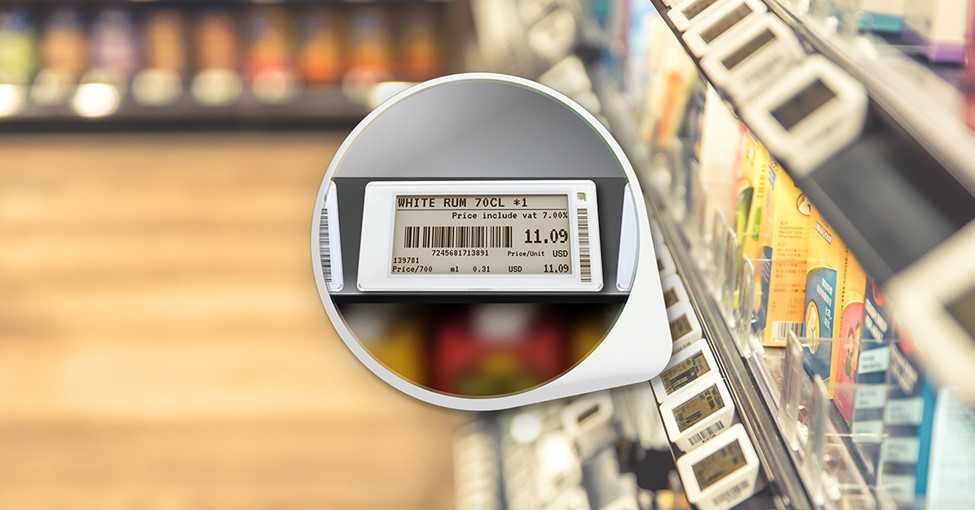Bluetooth Technology Supercharges Electronic Shelf Labels for RetailBluetooth技術が加速する小売業向け電子棚札の普及
|
Retail stores communicate basic product information and price to browsing shoppers through shelf labels placed near each product. Commonly, these are printed labels in plastic holders or metal stands. Now, we’re starting to see electronic shelf labels providing more information, quickly updated as price or other details change. Until recently, store clerks have had to reprogram these electronic shelf labels using an NFC- or RFID-based device. But that approach is slow and labor intensive. Shouldn’t a grocery store chain be able to update prices and other details from a central location? Of course, to scale out electronic shelf labels across large stores, they must be very low cost and should consume little to no power.

Retail Challenges and Opportunity
Brick-and-mortar retailers everywhere are under significant pressure. They face competition from other stores and online options and must be able to respond quickly and uniformly with pricing changes and special promotions. They also battle with familiar challenges – rising labor costs, high turnover, and a tight labor market, as well as inflation and supply chain problems. Yet, retail stores still have unique advantages through an in-person product and shopping experience. They want to keep those advantages but more effectively manage costs and flexibility with automation. Electronic shelf labels are a good way to help meet that goal.
Today, this is a somewhat niche market at 788M units installed but is expected to grow to three billion units by 2028. Unit prices today cost up to several dollars; these are expected to drop to support massive scale up, but this still represents a very healthy opportunity, approximately three billion or more for electronic shelf label makers.
Bluetooth Electronic Shelf Labels
Now, thanks to Bluetooth® technology, a large retail business can simultaneously and quickly update electronic shelf labels across the entire store with no need for manual intervention.
The Bluetooth Special Interest Group (SIG) ratified the Bluetooth® Core 5.4 release in February of 2023. The primary feature in Bluetooth Core 5.4 is support for Periodic Advertising with Responses (PAwR), and the main target for that feature is electronic shelf labels. The big step forward here is that PAwR allows for simultaneous broadcast from an access point (AP) to up to 7,000 devices. In earlier revs, store-wide updates would have required a ping-pong update to each label, taking significant time to update all labels. Now, thanks to Bluetooth technology, a large retail business can simultaneously and quickly update electronic shelf labels across the entire store with no need for manual intervention. One immediate payback is to reduce discounts demanded by shoppers because price labels have not been uniformly updated (this affects five to ten percent of purchases). Another benefit allows for fast response times in reaction to competitor price changes. Similarly, quick price responses to online competitors have been shown to reduce showrooming (checking out an item in store and then buying it online for a lower price) and increase brand loyalty.
The release of PAwR also allows electronic shelf labels to respond back to the access point staggered in allocated timeslots to avoid conflicts and interferences. The most immediate benefit of this feature is to acknowledge that each label has received and made the update. More appealing uses are to provide shelf stock status or added shopper interaction/assistance, for example, flashing the label when nearing an item they are trying to find or guiding them to the next item in their shopping basket.
Incidentally, because security is a high priority in any automation, Bluetooth Core 5.4 also includes support for encrypted broadcasting.
Bluetooth ESL Is the Scalable Solution
An open standard that can support open market solutions for access points and for electronic shelf labels with different characteristics/price points from a variety of suppliers is the only way to go.
Why not use Wi-Fi? Because it can’t meet the incredible broadcast reach of Bluetooth® Low Energy (LE). Remember also that electronic shelf labels must be very low cost. Builders are aiming at 40 cents for the radio, a much easier target for embedded Bluetooth LE than for Wi-Fi. Builders are also aiming at battery-less or very small battery devices, harvesting all or most of the required energy from ambient lighting or RF. While this option isn’t yet massively deployed, Bluetooth LE is the best candidate to meet this objective thanks to its low power consumption.
Today, most electronic shelf labels depend on proprietary radio interfaces, a technology provider lock-in that will be very unappealing to retail store owners already managing their costs carefully. An open standard that can support open market solutions for access points and for electronic shelf labels with different characteristics/price points from a variety of suppliers is the only way to go.
小売店舗では買い物客に、商品の近くに設置された棚札で商品の基本情報と価格を知らせます。従来は印刷された札をプラスチックケースや金属製のスタンドに入れて設置していましたが、今ではより多くの情報を表示でき、価格やその他の情報の変更に即座に対応できる電子棚札(ESL)を見かけるようになりました。ESLは最近まで、店舗スタッフがNFCまたはRFIDを使用した機器を使用して更新する必要がありました。しかしこのような方法は、時間と手間がかかります。食料品を扱うチェーン店であれば、ESLに表示する価格やその他の詳細について、中央から更新できて然るべきでしょう。また当然ながら、大規模な店舗全体にESLを設置していくためには、ESLが低コスト、かつゼロに等しい程度の低消費電力である必要があります。
小売業の課題と可能性

現在あらゆる地域において、 実店舗は厳しい環境下にあります。他の店舗やオンラインショッピングとの競争にさらされ、価格変更や特別セールによって素早くかつ画一的に対応する必要に迫られています。加えて従来の課題、すなわち人件費の高騰、高い離職率、労働市場のひっ迫、さらにはインフレやサプライチェーンの問題にも取り組んでいく必要があります。しかしなお、実店舗には実際にその場で品物を見て買うことができるという独自の強みがあります。実店舗は、こうした強みはそのままに、自動化による一層効果的な経費管理と柔軟性の向上を望んでいます。この目標を達成する最適な手段がESLです。
現在、ESL市場は設置数が7億8800万枚とニッチですが、2028年には30億枚規模に拡大すると予想されています。現行価格では1枚当たり最大で数ドルですが、価格は大規模な普及とともに大きく下がると見られています。それでも、ESLメーカーにとっては約30億枚以上と、極めて手堅いビジネスチャンスになります。
Bluetooth ESL
Bluetooth SIG (Special Interest Group)は、2023年2月にBluetooth®︎コア仕様5.4を公開しました。このバージョンの主な特長にPAwR (レスポンス付き定期アドバタイズ)がありますが、これは主にESLを対象としています。このPawRによってもたらされた大きな進歩が、アクセスポイント(AP)から最大7000のデバイスへの同時配信です。以前は店舗全体での更新には、通信によるやりとりが棚札ごとに必要であったため、全棚札の更新完了までに大幅な時間を要していました。しかし今やBluetooth技術によって、大型店でも店舗内のすべてのESLを同時かつ素早く、人手を要さずに更新できます。この効果をすぐに感じられる点の一つに、買い物客からの値引き要求の減少が挙げられるでしょう。すなわち、値札がすべて均一に更新されていなかったことを理由とした割引の要求であり、実に購入の5%から10%に影響しています。もう一つのメリットは、競合が行う価格変更に対し迅速に反応できる点にあります。同様に、オンラインの競合に対抗するための素早い価格変更は「ショールーミング」(実店舗で品物を確認してオンラインで安く買う行動)を減らし、店舗に対するブランドロイヤルティを高めることが示されています。
PawRのリリースによって、ESLからアクセスポイントに応答を返すことも可能になります。衝突や干渉を避けるため、応答はタイミングをずらしたタイムスロットで行われます。この機能によってすぐに感じられるメリットは、各棚札が更新を受信し実行したことを確認できる点です。さらに魅力的なのは、商品棚の在庫状況を示すデータを得られる点や、買い物客対応/支援を追加できる点にあります。たとえば、探している商品に近づいた際に棚札を点滅させて知らせたり、買い物リストにある次の商品に案内したりできます。
また、自動化においてはいかなる場合でもセキュリティが非常に重要になるため、Bluetoothコア仕様5.4は暗号化された配信にも対応しています。
高い拡張性を持つBluetooth ESL
Wi-Fiではいけないのでしょうか?なぜならWi-Fiでは、Bluetooth®︎ LEの驚異的な配信範囲に太刀打ちできません。また、ESLには極めて低コストが求められることも忘れてはなりません。開発者の目標はコスト0.4ドルで無線を実現することですが、その達成はWi-Fiよりも組み込み型Bluetooth LEのほうがはるかに容易です。また、デバイスのバッテリーはないか、あってもごく小型で、必要な全電力もしくは大部分を環境光かワイヤレス給電によって得ることも目標です。未だ大規模な普及はしていませんが、消費電力を低く抑えられるBluetooth LEはこの目的の達成に最適なのです。
現在、ほとんどのESLはメーカー独自の無線通信インターフェースを基盤としています。既にコスト管理に慎重な店舗オーナーにとって、このようなベンダーロックインは非常に不都合です。今後進むべき道は、さまざまなサプライヤーによって提供され、さまざまな特徴/価格帯のアクセスポイントやESL向けオープンマーケットソリューションに対応できる、オープンな標準規格の上にのみ切り拓かれるでしょう。